Smart retail refers to the hybridization between traditional shopping methods and modern technology, such as IoT and Internet to predict consumption trends, perceive consumption habits, provide consumers with diversified and personalized products and services, and guide production and manufacturing. He believes that both physical retail and traditional e-commerce need to change, and both need to integrate online and offline.
Reading this article will give you a full understanding of what smart retail is!
1. What is smart retail in IoT?
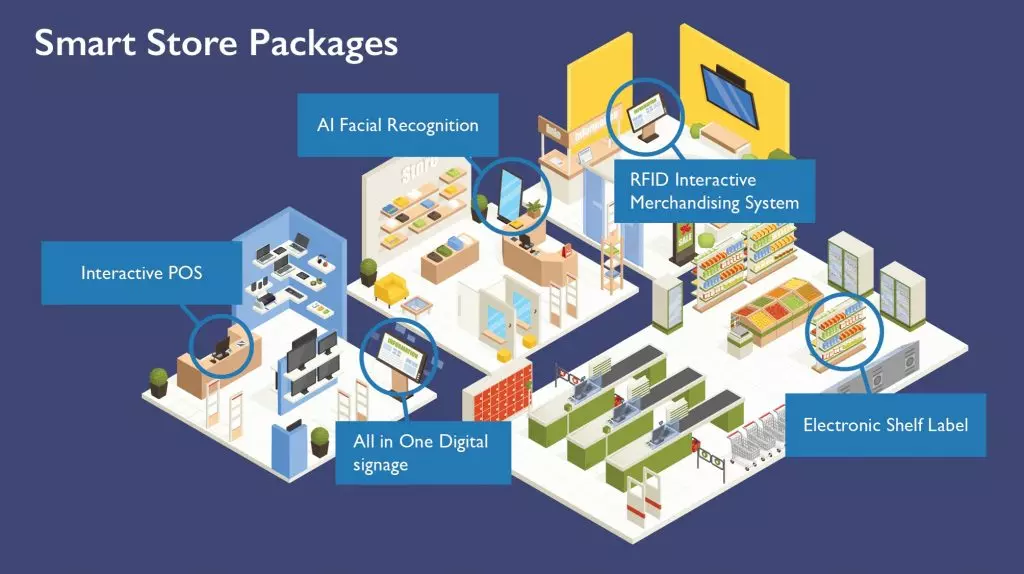
What is the shape of retail?
Alibaba said it was “new retail”, JINGdong said it was “the fourth retail revolution”, Suning said it was “smart retail”, NetEase said it was “new consumption”.
Every enterprise has its own views on retail, and different interpretations of the enterprise or from another dimension to think about retail. This is probably the newest thinking about retail since the advent of the term e-commerce, and let’s not get into the nuances of these concepts, but understand why they arise.
No matter how the Internet giants interpret it, retail is changing. The reason for this change is obvious. At the core, there are four main reasons for retail:
1. Mobile Internet and social networking drive consumers to become the new masters of buying and selling relationships;
2. The new trade mode represented by cross-border e-commerce and the globalized lifestyle carried by commodities are affecting the retail industry;
3. The promotion of international discourse power of Made-in-China endows Made-in-China brand value and promotes industrial upgrading;
4. The largest class migration in human history promoted the urgent demand for quality and aesthetics;
In fact, China’s new retail environment is far richer and more diverse than any other country. In particular, the convergence of business forms makes the boundaries between Internet companies, retail companies and technology companies increasingly blurred.
Especially since China has added mobile Internet technology and intelligent hardware technology to the scene innovation, and given China’s huge user base, any new business model seems to have extremely imaginative business prospects.
But no matter how retail changes, the user experience is still at the core of retail.
2. The history of smart retail

The story of retail automation is the story of all retail.
The focus shifted from human labor to the use of machinery for the first time in the industrial age. Since then, every technological innovation has been applied in retail in one way or another.
Today, every step of retail can be automated, and software products ensure that automation is not just the province of the big players. Small and growing retailers can also find ways to better serve their customers.
Turn of the century to the 1970s
There was also a big piece of machinery that made them happen while malls themselves were considered an innovation at the time. We mean the elevator, of course. It’s no exaggeration to say that the elevator was the first example of retail automation. It is now possible to open many stores in the same location and customers can move around more easily.
Another reason malls are so successful is that they are comfortable hanging out in hot weather! Air conditioning has been around for so long that it feels natural today. This novelty is making shopping malls bigger than ever and starting to become places where people are happy to spend the whole day and hope they make a lot of money.
So that’s how the story of retail automation began — with elevators and air conditioning. At the time, no one could have predicted that in less than 20 years shopping centers would face a new threat – the absolute convenience of shopping directly from our own couches.
Retail automation is the golden 90’s
The nineties were an interesting time to be in retail, just as advertising was a strange one. Leaving aside the fact that Mr Bezos could hardly recognise him as the big-headed retail genius we now know, could he have foreseen what Amazon would do to automation?
This vision had become what the brand logo sums up today by the year 2000. With brands evolving rapidly, we certainly need to give their strategy due credit, as well as payment automation due credit. To make such innovations possible.
Online payment is a form of automation because the payment gateway takes care of receiving money and processing transactions. Today, even bills are automatically generated. Imagine if you had to process millions of orders manually every day, so collecting money and making change was done manually.
The penetration of the Internet into people’s homes, supported by secure payment systems, has replaced telephone shopping as our preferred way to shop conveniently at home.
From 2000 to the present
Some companies can believe that most retailers will choose to automate multiple aspects of their business. ERPs or Enterprise resource planning systems had gone beyond basic functions by 2000.
For the first time, retailers can do more with their business because their clients are connected to the inventory side.
During this time, API and integration development has also increased, helping standard software products do more. For instance, a SaaS product may be an inventory management system, but it can use APIs to integrate with other software products for different retail functions.
So far, retail automation has followed an algorithmic model. It doesn’t take into account real-world anomalies that might cause the model to fail while it does work in most cases.
Intelligent retail automation – Towards the future
Just as the machine was the greatest innovation of the industrial age, artificial intelligence is the great breakthrough of the knowledge age. In addition, our system can use real models to understand this data.
The future of retail automation will bring it closer to the human decision-making process than ever before.
Stores that are experimenting to develop software that can fix their own stores when problems arise. For example, if something goes wrong with the checkout system, the system can fix the problem and keep it counteractive in a matter of minutes.
Amazon Go is an instance of taking self-checkout to the next level. Checkout counters are usually everyone’s least favorite space in the store.
Can retail be fully automated? At the current rate, we dare say it is. The use of sensors, heat maps and cameras in online shopping sites and stores are being touted as the next big thing in retail while controversial.
But we need to be able to address privacy concerns if observing a customer on camera may just be tracking. So are people willing to sacrifice their privacy for better convenience and intuitive shopping experience?
Advocates argue that it is espionage only when individuals are in the spotlight, and that heat maps often look at data from a few people at a time to understand general trends. Some critics also say that not many customers even know that their movements in the store are being tracked.
3. What are the characteristics of smart retail?
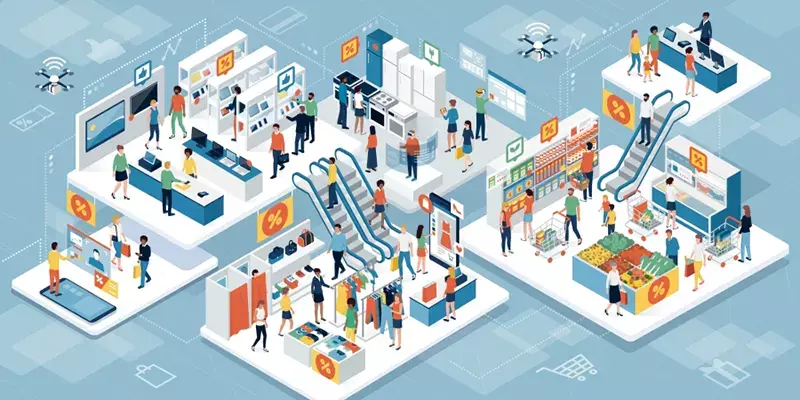
1. Ecology
New retail business ecological building will cover page, entity shop, online payment terminals, data system, logistics platform, marketing path and so on many aspects, and embedded diversified functions such as shopping, entertainment, reading, learning, and promoting enterprise online service, offline experiences, financial support, logistics support and so on four big ability to improve;
So that consumers can better meet the comfort and requirements of convenience and comfort in the shopping process in the shopping process, and thus increase user engagement. Of course, the commercial system built under the guidance of the natural ecosystem thought is inevitably composed of the main enterprise, the symbiotic enterprise group and the consumers, and shows a state of close connection, dynamic balance and mutual dependence.
2. Unbounded
Through the efficient integration of online and offline platforms, tangible and intangible resources, enterprises remove all kinds of barriers between retail channels in an “all-channel” way, blur the existing boundaries of each subject in the business process, and break the reality barriers such as the space-time boundary and product boundary existing in the past traditional business model. Facilitate the reasonable and smooth flow of personnel, capital, information, technology and commodities, and then realize the interconnection and sharing of the whole business ecological chain.
Relying on the enterprise system of “unbounded” retail, consumer shopping portal will become very scattered, flexible, variable and multivariate, people can at any time, place, in any possible way, go to enjoy, such as entity shop, online mall, TV marketing center, since the media platform and intelligent household and a series of rich variety of channels, Conduct a full range of consultation and interaction, exchange and discussion, product experience, scenario simulation and purchase of goods and services with enterprises and other consumers.
3. Smart
The important basis for the development and existence of the “new retail” business model lies in the gradual improvement of people’s requirements for immediateness, fragmentation, individuation, interaction, facilitation, and precision in the shopping process. To meet the above requirements, to some extent, it depends on the “intelligent” shopping mode.
In the era of “new retail” featuring channel integration, customer first, and the shopping scene people experience, the shopping process will have typical “intelligent” characteristics. Voice shopping, tablespace sensing, intelligent fitting, unmanned logistics, virtual assistant, photo search, VR shopping, and self-service settlement, will truly appear in front of consumers.
Online dimension
Online, in the “new retail” ecosystem, shoulders the important functions of sorting, information collection, and decision-making of consumers and merchants.
One of the main objectives of many commercial enterprises to implement the “new retail” strategy is to provide customers with a new way of shopping. In this way, customers can always and everywhere meet their purchase, social, leisure, entertainment and other needs in the whole consumption process, and the achievement of the above goals mainly depends on the innovation of online business models and technology application of enterprises.
4. What are the advantages/benefits of smart retail?

New consumption era, offline traditional consumption channels have been unable to meet consumer demand, more and more stores began to make wise retail stores, such as Ali’s box 7 fresh Ma Xian birth, jingdong, century lianhua, choose the future of the whale, yong hui super species new retail formats such as stores. What are the benefits of smart retail?
1. In terms of customer acquisition cost, smart retail mini program can accurately locate potential customers and save publicity costs.
2. Standardizing the order process will enable businesses to greatly save material resources and manpower. Unified processing orders, unified logistics distribution, easy to manage.
3. It can deliver the goods in a unified manner, which has obvious advantages in terms of logistics costs.
4. In terms of labor cost, the smart retail mini program includes the leader mode, which can mobilize community residents to serve as the leader, achieve better publicity effect and reduce labor costs.
5. From the perspective of service experience, pre-sales and after-sales customer service, order inquiry, reservation pickup, group killing, coupons, limited time and limited quantity and other marketing methods will give users a better use experience, effectively facilitate transactions, improve community conversion rate, and realize resource realization.
Wisdom retail small has developed since 2016, the outbreak this year, fueled by a lot of the growth of the industry, which also contributed to wisdom and retail, to a great extent stimulated the growth of the performance, let users group buying more accepted wisdom retail booking + to the mode, also get more new users involved at the same time, the whole market to expand at a draught N times.
5. How Does Smart Retail work?
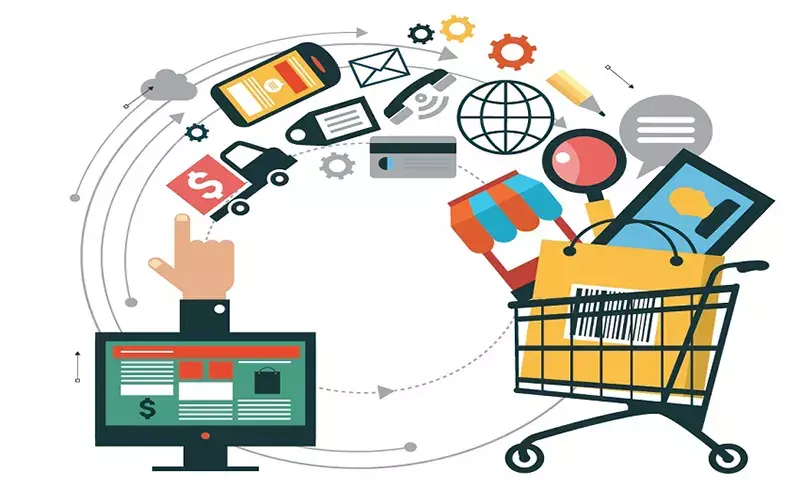
Digital and intelligent retail operation analysis system
Intelligent menacing retail era, both traditional offline retail enterprises, and relying on the Internet for birth of the new brand, need to face the reality of the game between personalized product design and production capacity, the personality needs of customers conflict with the efficiency of the supply chain cost, can use wisdom retail supply chain analysis system for digital production mode.
On the one hand, enterprises can grasp the operation of upstream supply chain in real time with the help of digital technology; Enterprise, on the other hand, with the help of intelligent system integration and deployment in enterprise Internet perception of manufacturing equipment, real-time data and synchronous sampling, for the enterprise management personnel to provide high-speed production information analysis results, the acceleration information of upstream and downstream of the iterative approach can make manufacturing enterprises could obtain the precise current business status and to make decisions.
Digital scenarios for delivery models create new experiences
The purpose of digital transformation of enterprise production mode is to realize the decentralization of product and service payment modes. Digital transformation runs through warehousing, e-commerce, retail and digital transformation, and then carries out omnichannel marketing coverage centering on the life and work trajectory of enterprise customers.
That is to say, (especially chain retail enterprises) in the face of retail sales in the process of the transformation of wisdom, all hope with the help of intelligent technology of science and technology to achieve unlimited time space, target groups to meet consumer demand, and the original offline store is more focused on consumer experience, depth, marketing services, Through O2O mode, online and offline service resources can be integrated.
The O2O delivery model of online consumption and offline delivery also makes it possible for brick-and-mortar chain stores to become the delivery interface of offline goods. On the other hand, online customers can also be guided to brick-and-mortar stores, thus opening the possibility of in-depth brand marketing. This kind of delivery experience is not only the improvement of consumer services, but also provides the “entrance” for the chain retail industry to integrate all channels of service resources.
Retail enterprises quickly build intelligent retail analysis systems through artificial intelligence technology, and build decentralized digital interactive offline marketing experience scenes, such as large interactive screens in new and first-tier shopping malls, which not only protect consumers’ privacy, but also provide them with an intuitive and interesting way to understand products in depth.
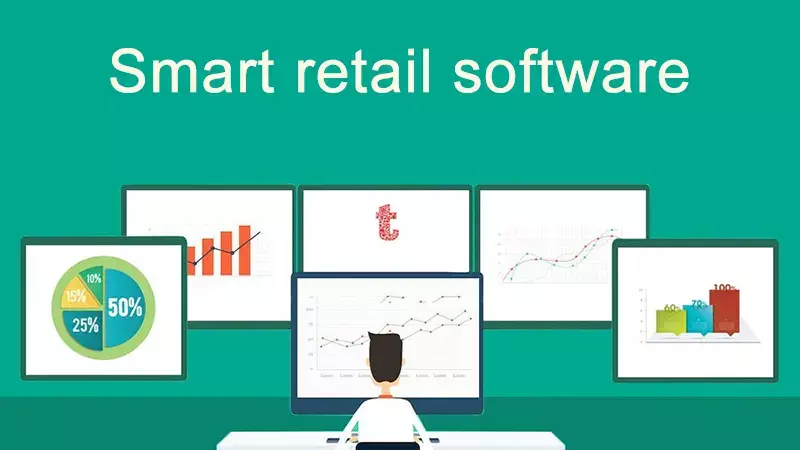
POS and Grab-and-go systems
Mobile POS solutions enable retailers to process sales transactions anywhere in the store. Retailers can improve the in-store shopping experience with smart POS systems.
Customers can buy items without interacting with a cashier with the “pick and go” system. The solution allows retailers to reduce time spent in-store.
Via Smart Retail participation system
Deliver compelling new consumer experiences via smart Retail engagement systems. The system not only allows you to create VIP customer programs to increase consumer loyalty, but also provides you with the data you need to track the performance.
The system’s fast and accurate facial recognition and analysis software support headcount, age, gender detection, and mood.
Smart Retail Management
Quant offers various solutions for the retail industry. You can effectively combine management of shelf maps, retail space, shelf labels, reporting, and marketing materials with task management in an integrated software system.
Intelligent retail
Simple, fast and reliable multi-channel EPoS one-stop service
With our combination of easy-to-use in-store EPoS, a fully integrated responsive website, the expertise of our digital marketing team and UK support, you will have everything you need to help you grow your business.
7. What technologies are used in smart retail
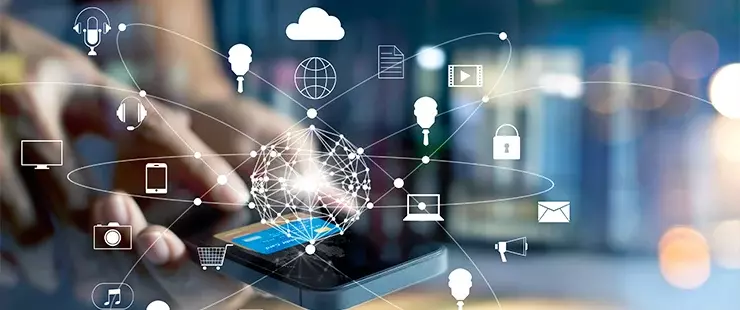
Beacon
These devices emit Bluetooth signals that can be used to drive sales through the store app by sending personalized alerts and push notifications about special offers and push notifications directly to customers’ smartphones. The technology is relatively cheap and can be applied to any existing retail business without major modifications.
AR/VR
These technologies allow retailers to improve the shopping experience by virtually bringing customers directly into their stores. Ikea’s virtual reality app allows shoppers to preview furniture in their homes before buying.
These solutions benefit retailers with physical stores because customers can personally experience the store and view the products on display or for sale. Customers can even visit stores virtually before they arrive at their destination with smart retail.
Fashion and beauty retailers can also let customers try on clothes virtually before making a purchase to see what suits them best. Virtual try-on also benefit customers with disabilities. Meanwhile, these solutions can enhance the customer experience by providing personalized recommendations.
AI
Retailers use this AI technology to automate certain processes in their businesses. For instance, retailers can use AI to analyze customer behavior and preferences in real time.
There are 4 main areas where AI smart retail solutions can come in handy:
Anticipate demand: AI solutions can track customer behavior on store websites, in-store or social media channels. Retailers can predict which products will be popular and adjust their inventory accordingly by analyzing this data.
Optimize prices: Retailers can monitor the prices of competitors’ products with AI. For instance, grocery stores could track customers’ purchases at different locations with AI.
Product recommendations: AI can also be used to recommend related products and upsell and cross-sell other items. They rely on customer preference data and then analyze that information so retailers can offer personalized recommendations or suggestions at the right time.
Predicting product size: AI can also help retailers determine the correct product size. For instance, it might offer different shoe sizes by gender and age group.
Reception bot
Retailers can now automate certain processes, such as customer service, through smart chatbots. By using front-desk chatbots, retailers can improve response speed and accuracy, leading to increased consumer satisfaction.
Chatbots also allow companies to personalize their communications with customers.
Ai chatbots also allow retailers to monitor the tone of their customer service interactions, and make it easier to quickly identify key issues for real-time resolution.
8. What are the actual use cases of smart retail

1. Casio’s first new retail smart store
Casio, which has always been leading the watch retail industry, also perfectly reflects intelligence in the layout of smart retail stores. In the stores, the queen comes to the motion sensing AR interactive game is worthy of becoming a sharp tool for store traffic diversion. Users can scan codes to get photos after interaction, which has obvious effect on attracting customers.
How to apply smart retail stores? Just look at these three application cases
Customers entering the store will be quickly attracted by the cloud shelf of Tmall interactive shopping screen, which has black technology to sense user behavior and supplement the SKU not found in the display store. Customers can browse the details of goods at will, and can place orders by scanning code directly through the mobile APP Taobao.
2. Walmart Smart Stores
Walmart started deploying smart retail in 2018. The Store in Long Island, New York, is called the smart Retail Lab. When you walk into the store, you can see the ceiling is covered with cameras and sensors designed to “monitor” shelf movements and help manage inventory.
They can accurately identify different items and quantities, for example, and their internal systems will notify store employees to restock if they are about to or already out of stock. At the same time, combined with real-time inventory, the shop assistant can also be clear about the purchase date and shelf life of vegetables, fruits and other goods.
3. Suning Smart Store
Finally, when it comes to smart store layout, the concept of Suning smart retail must be mentioned, such as business robots, unmanned stores, smart homes, AV/VR… All these are the tip of the iceberg that Suning smart retail shows in front of the public.
Taking Suning’s unmanned store as an example, users do not need to queue for payment when they buy goods in the store. When leaving the store, they go through an aisle and recognize the user’s identity through face recognition system, and directly realize payment transactions from Suning Yibao. Brush aside from “face” consumption, SuNing also is planning AR, VR, such as intelligent interactive way, realize a mix way of shopping, users need not to store also can realize the virtual stroll through television or mobile phone shop, synchronous know information such as in-store merchandising and sales promotion, even Suning logistics can be controlled by unmanned aerial vehicle (uav) will be delivered goods.
9. How big is the smart retail market?
The global smart retail market is anticipated to grow from $21.6 billion in 2020 to $62.5 billion in 2025; The compound annual growth rate was 23.6%.
Key factors driving the growth of this market are the increasing use of robots and automation.
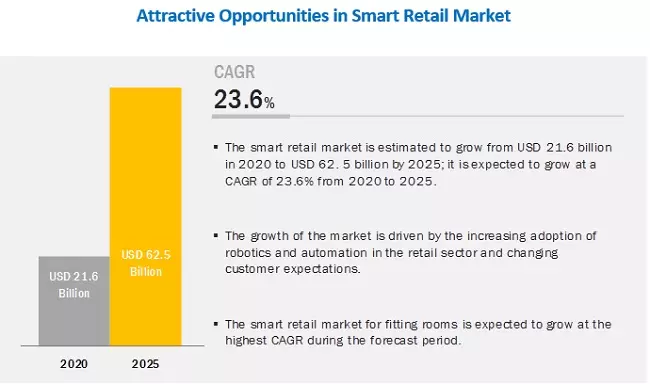
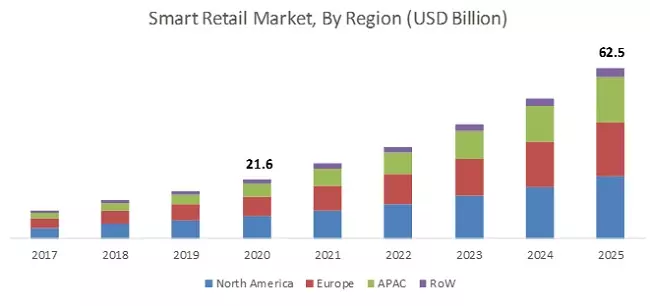
Robots streamline the process of finding the right product for customers. As a result, an increase in the deployment of robots has been observed in hypermarkets, other retail stores and supermarkets to make the shopping experience easier for consumers.
The traffic monitoring market will take the largest share of the smart retail market in 2022. The dominance is attributed to retailers’ increased awareness of foot traffic monitoring. In-store foot traffic monitoring is critical as it can provide retailers with insights into different aspects of the store.
The market in foot traffic monitoring is expected to grow at the highest CAGR during the forecast period
The market in foot traffic monitoring is anticipated to grow at the highest CAGR during the forecast period.
North America will dominate the smart retail market in 2022
North America has a large number of hypermarkets, supermarkets, and department stores. They have implemented automated storage and retrieval systems, POS solutions, smart trolleys, self-checkout systems, and ESL for their premises. As a result, North America took a major share of the smart retail market in 2019.
Major market participants
IBM (New York, USA), Intel Corporation (California, USA), Cisco Systems, Inc. (California, USA), NXP Semiconductors NV (Netherlands) and Microsoft (Washington, USA) are some of the major companies operating in the United States. Smart retail market. These companies have adopted both organic and inorganic growth strategies to strengthen their positions in the market.
















